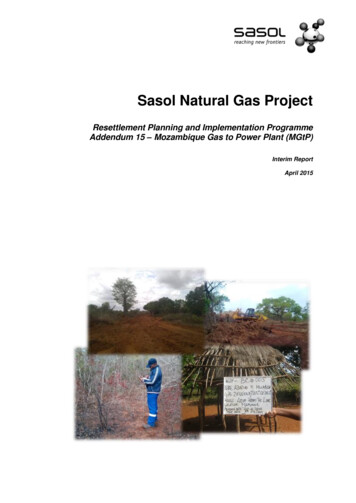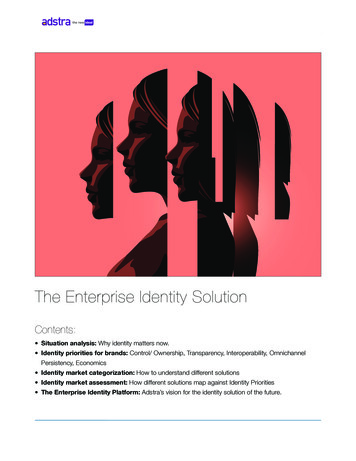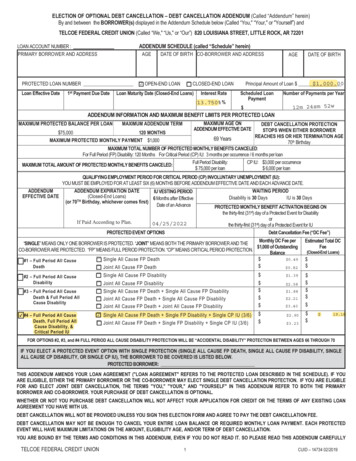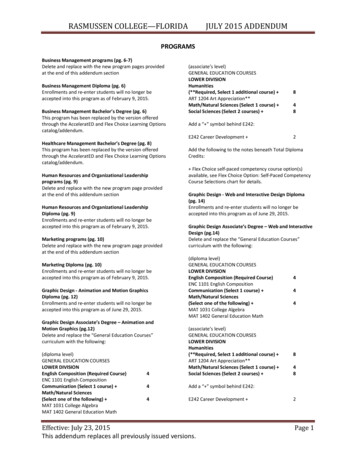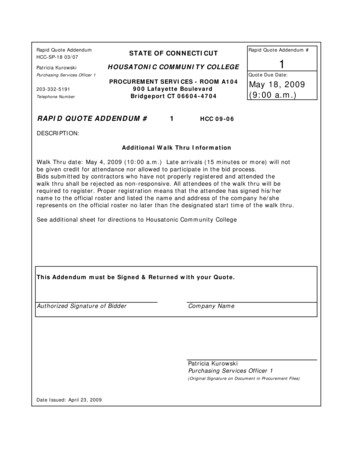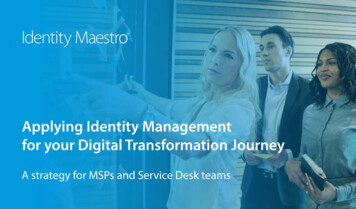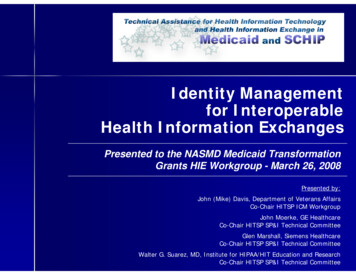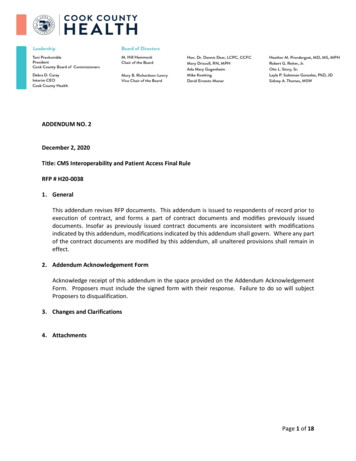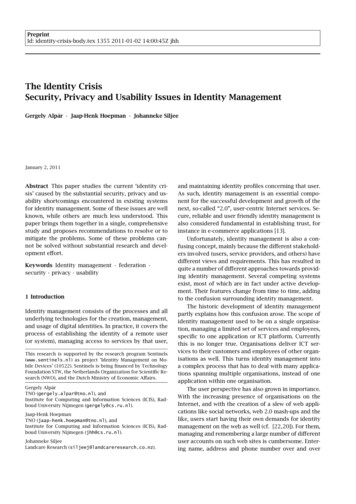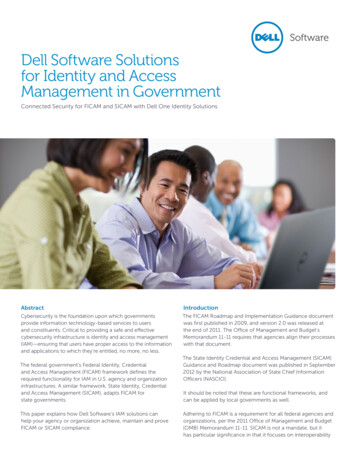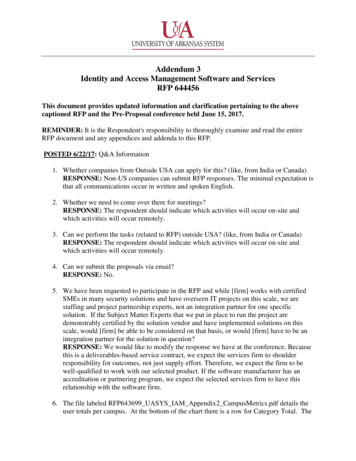
Transcription
Addendum 3Identity and Access Management Software and ServicesRFP 644456This document provides updated information and clarification pertaining to the abovecaptioned RFP and the Pre-Proposal conference held June 15, 2017.REMINDER: It is the Respondent's responsibility to thoroughly examine and read the entireRFP document and any appendices and addenda to this RFP.POSTED 6/22/17: Q&A Information1. Whether companies from Outside USA can apply for this? (like, from India or Canada)RESPONSE: Non-US companies can submit RFP responses. The minimal expectation isthat all communications occur in written and spoken English.2. Whether we need to come over there for meetings?RESPONSE: The respondent should indicate which activities will occur on-site andwhich activities will occur remotely.3. Can we perform the tasks (related to RFP) outside USA? (like, from India or Canada)RESPONSE: The respondent should indicate which activities will occur on-site andwhich activities will occur remotely.4. Can we submit the proposals via email?RESPONSE: No.5. We have been requested to participate in the RFP and while [firm] works with certifiedSMEs in many security solutions and have overseen IT projects on this scale, we arestaffing and project partnership experts, not an integration partner for one specificsolution. If the Subject Matter Experts that we put in place to run the project aredemonstrably certified by the solution vendor and have implemented solutions on thisscale, would [firm] be able to be considered on that basis, or would [firm] have to be anintegration partner for the solution in question?RESPONSE: We would like to modify the response we have at the conference. Becausethis is a deliverables-based service contract, we expect the services firm to shoulderresponsibility for outcomes, not just supply effort. Therefore, we expect the firm to bewell-qualified to work with our selected product. If the software manufacturer has anaccreditation or partnering program, we expect the selected services firm to have thisrelationship with the software firm.6. The file labeled RFP643699 UASYS IAM Appendix2 CampusMetrics.pdf details theuser totals per campus. At the bottom of the chart there is a row for Category Total. The
totals across any of the rows do not match the numbers in the Campus Total Column.Can you please provide clarification around that?RESPONSE: Some column counts are included in the counts for other columns: The“Students” column counts all students, including “incoming students.” The “total alumni”column counts all tracked alumni, including “new alumni.” The “campus total” columnsums employees, students, applicants, and “total alumni.”7. There is mention in the RFP of Federated Single Sign-On. Would you happen to knowhow many Federations will need to be deployed to satisfy the University of Arkansas usecases?RESPONSE: There will be at least two Federations, however, consider this numberunbounded. We hope to see recommendations based on your expertise.8. There is mention for integration with a Security Information and Event Manager. WhichSIEM does the university currently use or will this be a future purchase?RESPONSE: Fayetteville uses Splunk, the other campuses may be using different tools.Some campuses may not have a SIEM tool in place.9. Approximately how many downstream target systems are there?RESPONSE: At a minimum, expect a directory (Active Directory or LDAP) and aLearning Management System (LMS) (Blackboard or similar) per campus. We expectauthentication to go through standard systems (AD/Kerberos, SAML, RADIUS), so theywill not be counted. Some additional downstream provisioning is expected, but thesenumbers are unknown.10. What is the primary System(s) of Record?RESPONSE: The IAM platform will be the system of record for identity once it isestablished. We expect the new ERP platform to be authoritative for the attributes itmanages.11. Multi-Factor Authentication (MFA), aside from One Time Passcodes are thererequirements for integration with 3rd party MFA solutions?RESPONSE: We desire a complete MFA solution that integrates with desktop login,federated single sign-on (SSO), and other authentication mechanisms. We prefer systemsthat implement open standards.12. Is Reverse Password Synchronization required?RESPONSE: While not required, we desire the ability to synchronize passwordsbetween campus directories and the IDM.13. Is a vendor precluded from participating in Phase 2 (implementation) if they respond toPhase 1 (software/SaaS) and are the winning vendor?RESPONSE: No. Any vendor that participated in the pre-proposal call may respond toeither phase, or both phases. Vendors may also submit a combined bid addressing bothphases.
14. We are assuming BASIS is the locally developed mainframe application. If that is thecase, what is the platform? RACF? Other? Please explain the integration via “scripts”to combine the SIS and BASIS data to form a single identity in a bit more detail. Whichlanguage is used? Do you expect your vendor to replace the scripts used to export theinformation from the mainframe and SIS?RESPONSE: (This answer applies to the Fayetteville campus.) The BASIS application isdeveloped in Natural and ADABAS, providing both 3270 (green screen) and web-basedinterfaces. RACF authenticates 3270 sessions, and LDAP authenticates web sessions.Nightly batch processes on the mainframe and in the PeopleTools environmentsynchronize information between the two systems, and produce a flat file is used toprovision accounts in LDAP and Active Directory. We expect the chosen solution to beable to supplement these capabilities as the current Mainframe and PeopleSoft systemsare transitions to the new ERP platform.15. It appears you have a fairly extensive Authentication infrastructure. Which specificcomponents will be replaced by your vendor of choice? Please further describe yourdesired future statue for your authentication infrastructure and user experience.RESPONSE: Not all campuses have the same authentication infrastructure. We desire asystem capable of providing all authentication functions. If the chosen solution lacksdesired functionality, we will explore integrating third party tools with the chosenimplementer.16. Do you want to maintain the batch processing for SAP or look to introduce more direct,seamless integration and eliminate the FTP step?RESPONSE: The goal with any such integration is to remove latency from the process,moving away from batch processing toward more real-time flows.17. Will users that are both faculty and staff have two domain accounts? How would youlike to handle multiple affiliations for both authentication and domain access?RESPONSE: We envision a single account per user. Most, if not all, campuses alreadyuse a single domain. We envision that affiliations will be expressed via roles or otherattributes, and that these attributes will be used with a rules engine to determine the stateof each individual's affiliation with each campus.18. Are you looking to combine all 5 campus into a single IAM solution or do you foreseeseparate instances for each campus?RESPONSE: We hope to see recommendations based on your expertise. We envision aunified IAM solution for the entire system. The goal is to enable an individual to begintheir affiliation with one campus and transfer from there to multiple campuses thereafter.An individual may have many roles at several campuses simultaneously. In all cases, wewant to view that individual as a single entity from the perspective of IAM. Respondentsmay choose to propose a single-tenant approach, a multi-tenant approach, or any otherapproach that addresses the System's goals.19. Is vendor registration mandatory for this bid? If yes, then by what date, can I registerInfosys with your procurement department?
RESPONSE: Complete the VII form (as provided in the RFP) and submit the completedform with your bid. That's the form we need to register your vendor in our system.20. In the section 14.2, Software scope of RFP Phase 1 is provided. However as weunderstand, in RFP Phase 1 we only need to suggest the solution along with thesubscription/licensing/hosting cost. The implementation cost of this scope is to beprovided in the RFP Phase 2. Please confirm.RESPONSE: This is correct.21. What is the number and type of sources of identity that need to be integrated to the IDMsystem?RESPONSE: The primary identity source will ultimately be the new ERP system.However, each campus has existing IDM systems that will need to have their informationpreserved. Respondents should plan to migrate that information, and for their proposedIDM system to replace any identity/account generation tools currently in place as eachcampus transitions to the new ERP platform. Refer to the Appendices 1 and 5 forexamples of systems in use. Expect other campuses in the same class (2-year vs. 4-year)to have similar platforms in use.22. What is the number and type of target systems for identity provisioning to be integratedto the IDM system?RESPONSE: Please refer to our answer to question 9.23. What is the new ERP system that needs to be integrated?RESPONSE: The RFP for the new ERP system has not announced its intent to award.The finalists are Oracle Cloud and Workday.24. What is the approximate number of identity provisioning workflows needed to be setup?RESPONSE: We expect to need at least 3 workflow types: an automatic full flow thatprovisions most (if not all) attributes, e.g. into a directory; an automatic partial flow forprovisioning account information into a downstream application, and a manual/ad-hocflow for provisioning special-use or local accounts, e.g. for conferences, workshops,summer camps, etc.25. What is approximate number of different type of roles that need to be setup?RESPONSE: We envision many hundreds of roles will be needed per campus. Weenvision a layered role design, where certain roles (e.g. "student") are more general andmay apply to all campuses, while other roles are specific to a campus and may not makesense or be visible beyond its scope.26. What is the scope of Multi-Factor Authentication?RESPONSE: We envision Multi-Factor Authentication (MFA) to be available at allcampuses, to all users, including students, and required for some individuals whose riskscore is higher. The proposed MFA solution may replace the extant system at UAMS. Weprefer a solution that provides a variety of MFA methods (e.g. SMS, smart phone app,token, fob, smart card), but we choose not to make any of these required. We envision anMFA solution capable of performing "step-up" authentication, that is, an authentication
system that allows single factor for low-risk users or activities, but returns to request thesecond factor when it becomes needed.27. What is the approximate number of approval workflows for roles and access provisioningthat need to be setup?RESPONSE: We expect to need at least two workflow types for role and accessprovisioning: An automated flow that assigns roles or access based on an individual'sattributes and a set of rules; and a manual flow that allows individuals to request certainroles or access, but have that access approved, either by automated process, or by humanreview and approval.28. How many different pre-prod environments need to be setup- Dev, SIT, UAT?RESPONSE: We hope to see recommendations based on your expertise. We believe thisnumber to be solution-specific; respondents should propose the structure they feel bestmeets our other needs. However, we expect to have at a minimum a separate instance totest and train with that does not operate on live data. A method of testing or simulatingthe effects of large changes on our live data set is also desired.29. Any preference to specific Cloud platform for hosting the IAM solution?RESPONSE: No preference.30. What is the current authentication system/mechanism and user directory being used?RESPONSE: This varies by campus. See Appendices 1 and 5. Common currentplatforms include LDAP, Active Directory, and Google Apps for Education. In somelocations, authentication may be performed locally, rather than against a directory-bornecredential.31. What are different types of authentication mechanism that are required?RESPONSE: We expect all campuses to be interoperable, and to use industry standardprotocols such as Kerberos, SAML, and RADIUS. Some public key or certificate-basedauthentication may be used in certain areas. We desire to deprecate LDAP as anauthentication mechanism where possible, because of its lack of true AAA functionality.We desire to implement Multi-Factor Authentication at all campuses, and for allauthentication mechanisms (AD/Kerberos, SAML, RADIUS).32. Is there a requirement for coarse/fine grain access management or only Single Sign On isrequired?RESPONSE: We expect federated SSO to support the assertion of entitlements, roles,group memberships, and other salient attributes, as each application needs these, eitherfor authorization purposes, or for just-in-time provisioning.33. What are different types of Multi-Factor Authentication mechanisms that need to besupported?RESPONSE: We desire flexibility in the MFA mechanism, to improve the end-userexperience. Without requiring any specific mechanism, we are interested in seeing both a"lowest common denominator" solution, such as SMS or phone call, as well as a moreuser-friendly method such as a smart phone application, a physical token, or smart card.
Smart cards that can double as a campus ID card may be considered as well. Respondentsmay suggest any mechanisms they feel will meet the System's needs.34. Is Risk based and Adaptive Authentication required?RESPONSE: While not required, risk scoring, adaptive authentication, and step-upauthentication are desired features. We desire to identify varying risk in individuals,tasks, and data, and adjust security requirements accordingly. We may choose to varypassword lifetime for low- or high-risk individuals, permit single-factor authenticationfor low-risk activity, but step up authentication with a second factor if privileged actionsare to be performed.35. Is there a requirement of Privileged Access Management?RESPONSE: Privileged Access Management (PAM) may be proposed for both root andother administrative account control, as well as for the management of shared accounts.36. [Firm] will have several respondents potentially to this RFP, we’re working with severalpartners on responses currently. Is it ok for me to join the call today and representmultiple potential responses?RESPONSE: Yes.37. I just missed the pre-proposal conference due to a flight delay. Are we still able torespond to RFP 644456 for Identity and Access Management Software and Services?RESPONSE: Unfortunately, since [firm] was not represented on the pre-proposal callthis morning we will not be accepting a bid submission directly from [firm]. However, if[firm] will be partnering with another company that was represented on the call, then wecan accept a joint bid as submitted by that partner.38. Whitney, a question that came up on our internal post review call today was aroundservices. At this point UARK still has a few considerable unknowns. Building servicesaround these unknowns leaves a lot of room for interpretation. For example, the [product]has over 5,000 pre-integrated applications like Workday. If UARK chose Workday astheir ERP solution this would reduce the services needed to install [product]. We do notwant to miss-represent our services or build unnecessary cost into the services proposal.Question: Will UARK be able to address these unknowns prior to the bid date and leaveroom to adjust to these updates? If not, how would UARK suggest a respondent to goabout the proposal give these unknowns?RESPONSE: In the specific case of the ERP, we suggest that vendors may want toaddress their solution's approach to both ERP finalists, Oracle and Workday. For otherunknowns, we are unable to offer guidance.39. In RFP643699 UASYS IAM Appendix4 Requirements.xls, User interface andexperience, line 92: “The solution provides a complete IoT/mobile experience.” Are wetalking about devices provisioning or about MDM features/end users experience? Howimportant is this feature to you?RESPONSE: This requirement is not meant to address any MDM need. We desire asolution that is built with mobile performance in mind. If the user interface is browserbased, the system should work with any modern browser, and should work on mobile
platforms (phone, tablet). If a smart phone app is available, please indicate that.References to IoT are intended to represent the collection of technologies outside ofnormal desktop, client/server, and mobile interactions. This may include building accesscontrol, kiosks, printing, campus safety, audience response ("clickers"), and other similartechnologies. In this context, IoT support is focused on provisioning and access control.40. We would also be very interested in bidding on the Services work (Phase 2), dependingon which platform you decide to move forward with. If you can also let us know whenthat decision has been made that will allow us to craft a response for the bid, additionallyknowing the selection for the ERP system would help with how we can address ourresponses. While we have done both Workday and PeopleSoft implementations it wouldjust allow us to be more specific in the document.RESPONSE: We will announce a winner for Phase 1 before the Phase 2 deadline. IfPhase 1 is delayed, we will adjust the deadlines for Phase 2 accordingly.41. The file “RFP Appendix 1: Diagrams of Current Environments” is corrupted. Pleaseshare it again.RESPONSE: Thank you for telling us. We will address any file corruption issues.42. If the answers to these questions are not readily available, please share approximatenumbers or list assumptions to work with:a) What is the approximate number and type of sources of identity that need to beintegrated?b) What is the number and type of target systems for identity provisioning to beintegrated?c) What is the number of applications that will be integrated?d) What would be approximate number of different type of roles?e) What is the approximate number of approval workflows for roles and accessprovisioning that need to be setup?f) How many workflows for attestation of rights need to be setup?g) How many federation partnerships need to be set up?h) How many applications would need SSO?i) How many applications need to integrated for Multi Factor Authentication? Whatis the Multi-Factor Authentication method required?j) In case of On-premise solutions, how many Datacenters University has (for hybrid,HA, DR Planning, Deployment Topology).k) Any specific Non Functional Requirements (Performance Metrics).RESPONSE: For each part.A) Refer to question 21.B) Refer to question 9.C) Refer to question 9.D) Refer to question 25.E) Refer to question 27.F) Refer to question 27.G) Refer to question 7.
H) We believe this number to be large. Fayetteville today has over 100 service providers(relying parties) served by its Shibboleth SSO instance, with several others served byAzure AD. We expect other 4-year campuses to have similar scale, with 2-year campusesusing fewer applications.I) Multi-factor authentication should be implemented such that it can protect anyapplication, including desktop login, remote shell access, and federated SSO. Refer toprevious questions about the number of applications deployed. Ideally, MFA will beapplied at and through the authentication interfaces (Kerberos, LDAP, SAML, RADIUS),and not through an application itself. Refer to questions 10, 25, 32, and 33 for furtherexposition.J) For an on-premises implementation, we may elect to use datacenters on multiplecampuses, making 5 or more geographically diverse datacenters available. Ifimplemented at a single campus site, expect to use no more than 2 datacenters for onpremises implementation.K) Respondents should describe any capacity limits within their solutions. For example,are there caps on the number of users, roles, groups, served applications, activefederations, or any other item used? Respondents should describe the throughput limitswithin their solutions. For example, how quickly do changes to an entity’s informationconverge and propagate out to “downstream” systems? How much time passes after thecreation of new polices, rules, or workflows before they propagate and go into effect?43. Please list your priority for IAM deployment - on premise vs cloud?RESPONSE: We believe that a cloud (SAAS) solution or hosted implementation of anon-premises solution will be preferable to directly implementing the on-premises solutionin our datacenters. Remember that innovative solutions are welcome. Do note that allresponses to the RFP must propose a cloud (SAAS) or hosted solution, as we believe thismaintains uniformity in proposal structure.44. By when can we expect these clarifications to be made available to us?RESPONSE: We plan to post responses by Wednesday, July 21.45. Given the complexity and detail required for proposal responses, with current due datesin and around Independence Day, would the System please extend the due date for bothphases by at least two weeks so that vendors may adequately account for answeredquestions into final solutions and subsequently provide compliant and qualifiedresponses?RESPONSE: We have decided to extend the deadline. We will communicate the newdeadline through our normal channels. See Addendum 2.46. Are both Phase 1 and Phase 2 proposals due on the same day or are they due a week apart? There was conflicting information between Mandatory Con-Call and the RFP.Would the System please clarify?RESPONSE: Phase 1 and Phase 2 have different deadlines as outlined in the RFP, andthe modified timeline in Addendum 2. The Phase 1 deadline applies to those proposing aphase 1 only proposal, or the software portion of a combined proposal.
47. Part of the ‘vision’ for the IAM is: “simplify the process of applying to colleges anduniversities” – it is unclear in the remainder of the document how the IAM solution willmeet this part of the vision. Please elaborate on how this part of the vision is met basedon the detailed requirements provided.RESPONSE: We envision a future where prospective students may apply to multiplecampuses through a unified application process, as is available in other states. We viewunified identity as an integral piece of the lifelong learning relationship that individualswill have with their campus(es).48. How does the “System” vision this IAM solution helping with “Simplify the process ofapplying to colleges and universities”?RESPONSE: Refer to question 47.49. How does the “System” vision this IAM solution helping with “Simplify the process oftaking courses at multiple campuses”?RESPONSE: Refer to question 47.50. What is the “Systems” decision of no on-premise solutions based on, are there specificitems that have led to this decision?RESPONSE: There were many considerations regarding the System’s decision tospecify either a cloud or hosted platform for delivering the solution. For proposalpurposes, the System is not entertaining an on-premises solution.51. The RFP indicates that the IdM becomes the source of authority for identity information.The source of authority is typically the origination of user information, such as an HRMor SIS and the IdM is the coordinator. By stating that the IdM is the source, it indicatesthat it will not receive any user information from another system (like the HRM or SIS)and that updates to information (such as a name change) must always originate from theIdM as the authoritative master of information. Please confirm that this is UARKsintention or provide clarifying wording to better indicate the relationship between theIdM and the source systems.RESPONSE: As we have discussed our accounts are created and used today, it hasbecome clear that there are many exceptions to the expected flow illustrated by thisquestion. Not everyone who needs a user account necessarily exists in the ERP, and noteveryone in the ERP necessarily needs a user account. Our intent is to illustrate that thesemany edge cases must be addressed by the IDM platform, as we believe it is the onlyplatform equipped to do so. Attributes that the ERP hold authority for may be delegatedto the ERP, if the IDM supports that feature (e.g. tell the IDM that for users that existwithin the ERP, delegate attributes such as address and date of birth to the ERP). Mostimportantly, we wish to avoid a scenario where the ERP is consulted as "authoritative"for some users, but the IDM or another system is consulted for other "non-ERP" users.We desire a single point of authority for all applications. Ideally, even the ERP wouldrely upon the IDM for authentication and access control, and identity informationwhenever possible, though this circular reference is a unique point, and is not arequirement.
52. Please indicate whether the future ERP is a source or a target of the IdM.RESPONSE: Refer to question 51.53. The RFP only discusses provisioning and deprovisioning – if there are other scenarios(such as changes of name, status, role, etc.) please list them.RESPONSE: All of these scenarios are part of this RFP and are generally consideredpart of "Identity Lifecycle Management."54. Please indicate the use cases for multi-factor authentication.RESPONSE: Refer to questions 11, 26, 33, 34, and 42(i) for further exposition.55. The RFP indicates one of the requirements: “Identity and access governance processesare consistent and being used throughout the System”. While a tool can help to automateportions of the processes, governance requires a measurable amount of periodic peopletime from various organizations. As this is listed under the “Implementation Services”category, does this mean that UARK intends for the service provider to ensure thatpersonnel from the various campuses are performing their governance duties?RESPONSE: No. The intent is that the service provider will assist our staff in definingand establishing the processes necessary for good governance, and will provide trainingfor the core staff in executing and maintaining those processes over time.56. The RFP indicates one of the requirements: “Audit and compliance reviews areautomated, and produce relevant documentation.” Does UARK intend ‘reviews’ here or‘reports’? As reviews require user participation, that necessitates at least one manualstep, preventing complete automation.RESPONSE: This is correct. The correct wording is "reports." We wish for automatedreports as part of the audit and compliance process. We do expect that the serviceprovider will assist our staff in building review processes that provide input to thoseautomated reports.57. The RFP indicates one of the requirements: “ID card systems rely on IAM forinformation. IAM exploits ID cards to control building access and possibly computeraccess, based on the needs and abilities of each unit.” The wording for this item seems toindicate that the IdM would control building access. Please confirm that the intent here isthat the IdM would integrate with a building access management system and potentiallyassign rights based on defined roles. Please further confirm that the intention ofcontrolling computer access is for ID cards to be used as a multi-factor authenticationmechanism.RESPONSE: Yes. The expectation is that IDM will integrate with building accessmanagement systems. The vision for computer access through ID cards is multi-factorauthentication, such as a smart card reader, USB or RFID token.58. The RFP indicates one of the requirements: “Each person has the ability to manage theirrelationships with the System and their local campus or unit through self-serviceaccount/attribute management”. Please elaborate on what sort of attribute andrelationship management UARK envisions users wanting/needing to perform.
RESPONSE: We desire to reduce friction for end users, and repetitive actions by staff inupdating user records. We desire an individual to be able to update his or her address,phone number, email addresses, and other personal information. Since the IDM platformwill manage users known to the ERP as well as users external to the ERP, we believe it tobe best suited to support this functionality. Of course, we remain open to alternativesolutions.59. For the federated single sign-on requirement, please confirm that appropriate interfacesare already available for the listed services or that UARK will take on the responsibilityfor providing appropriate interfaces for SSO/federation technology to integrate.RESPONSE: We believe the appropriate SAML interfaces already exist for all listedservices. We do not expect a vendor to build a SAML interface for a third party that lacksone.60. Please elaborate on what UARK considers ‘preserving the unique “identity” or spirit ofeach campus or unit’.RESPONSE: While there is one "University of Arkansas" system, our students do notthink of themselves in that way. Students at each campus take pride in their schoolidentity and in their "belonging" to that school. A UALR "Trojan" would be insulted tobe mistaken for a Razorback. While we desire to unify identity to improve inter-campuscollaboration and transfer of students as they pursue their studies, we in no way want tomake a student's experience generic, or to sever the bond they have with their campus.61. The RFP indicates that the IdM should be online and integrated with all campuses inadvance of the ERP. Is UARK aware that integration of the ERP as a feed into an IdM(as opposed to a consumer of the IdM) after campuses have been tied in meansreworking/replacing all of the connectors built to gather information from the sourcesystems at the campuses and a major data reconciliation effort to synchronize existingdirectory data with the ERP?RESPONSE: At Fayetteville, the current user account generation
Identity and Access Management Software and Services RFP 644456 This document provides updated information and clarification pertaining to the above captioned RFP and the Pre-Proposal conference held June 15, 2017. REMINDER: It is the Respondent's responsibility to thoroughly examine and read the entire RFP document and any appendices and .
